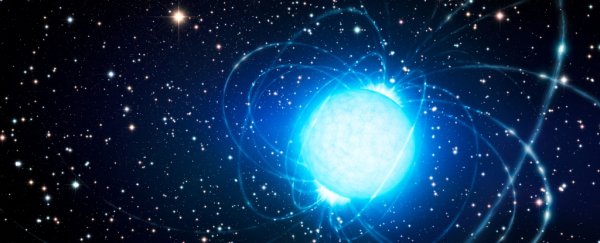One of the rarest and most mysterious stars in the galaxy has just been spotted behaving really strangely. Swift J1818.0-1607 is a magnetar, and astronomers have just recorded it spitting out staccato radio pulses.
This makes it only the fifth magnetar ever detected emitting pulsed radio waves… but it's also doing so in a manner unlike any of the other four. Swift J1818.0-1607 was behaving more like a radio pulsar than a radio magnetar.
A paper describing the event has been uploaded to pre-print server arXiv, and is yet to be peer reviewed. The observations could help astronomers to connect the dots between these two classifications of dead stars.
"I think it is safe to call it a potential missing link," astrophysicist Marcus Lower of Swinburne University of Technology told ScienceAlert.
"At this stage there's still a lot we don't know about this new magnetar, but there are clear similarities between it and the high-magnetic field pulsars."
Magnetars are really peculiar little oddballs. They're a subcategory of neutron stars, which themselves are the incredibly dense core remnants left behind after a massive star goes supernova.
What makes magnetars stand out is their insanely powerful magnetic fields. We're not talking small potatoes here. These magnetic fields are around a quadrillion times more powerful than Earth's, and a thousand times more powerful than a normal neutron star's. And we still don't fully understand how they got that way.
They're also really rare. We've only detected around 24 of these extreme stars in our galaxy to date, and of those, just a handful have been observed emitting radio waves.
Pulsars, on the other hand, are much more common - astronomers have identified thousands. These are rapidly spinning neutron stars that beam jets of radio radiation from their poles; when those jets are oriented to flash past Earth, they pulse, like a rapid cosmic lighthouse, on timescales as short as milliseconds.
Because both pulsars and magnetars are a kind of neutron star, it's expected that there would be some crossover between them, but there has been surprisingly little. Initially, this was thought to be because the magnetic field was too powerful to support pulsar-like radio emission.
More recently, however, the thinking has shifted. Astronomers believe that most magnetars are just facing the wrong way.
"The most likely reason is their radio beams simply don't cross our line-of-sight," Lower explained. "This isn't too surprising, as their slow rotation periods and the high rate at which they're slowing down over time causes them to have very narrow radio beams when compared to other pulsars."
That brings us back to Swift J1818.0-1607. On 12 March 2020, it was detected undergoing a gamma-ray outburst by the Burst Alert Telescope attached to the Swift Observatory. Follow-up observations quickly followed, detecting pulsed X-ray emission.
Two days later, radio emission was detected, and initial analysis found that Swift J1818.0-1607 is the fastest rotating pulsar found to date - and it is likely also the youngest, just 240 years or so.
Using the Parkes Observatory radio telescope in Australia, Lower and his team also took observations. They recorded the star for three hours, and found it emitting pulsed radio waves, not apparently very different from the other radio pulsars. But then they took a closer look at the data.
"At a glance, the radio pulses emitted by Swift J1818.0-1607 look quite similar to those from the four other radio magnetars. They're very narrow and sometimes composed of multiple millisecond-long bursts," Lower said.
"However when we looked at how bright the pulses are at different radio frequencies, we realised there is a dramatic drop-off in brightness when going from low to high frequencies. While this is similar to many ordinary radio pulsars, it is very different to the pulses seen from other magnetars. They tend to have an almost constant brightness across the radio spectrum."
In fact, the radio outburst bore a striking resemblance to one pulsar in particular. In 2016, a high magnetic field pulsar called PSR J1119-6127 underwent a radio outburst of its own, and the spectrum of that outburst looked very similar to the spectrum from Swift J1818.0-1607.
In addition, Lower explained, the two stars exhibited a similar radio brightening - a tantalising hint that the mechanism behind the radio outbursts could be similar.
It could also suggest that at least some magnetars could evolve from pulsars. How this process would play out is unclear, but there are a number of scenarios. A rapid slowdown in the rotation rate could cause a neutron star to exhibit the rotational properties of a magnetar. Alternatively, a collapsing neutron star could have a magnetar-like magnetic field from the start, but it's buried under fallback material from the supernova, and takes some time to reemerge.
More observations would be needed to confirm. Magnetars are incredibly difficult to detect in the first place, so expanding the catalog is a challenge, but now we know that Swift J1818.0-1607 behaves this way, the star could become a bridge over that knowledge gap if we can study it for longer, and with more sensitive instrumentation.
"That this magnetar's radio emission doesn't exactly match our expectations from observations of other radio magnetars is quite exciting, and goes to show how much more we have yet to learn about these extreme objects," Lower told ScienceAlert.
"Its similarity to more mundane pulsars opens a whole host of questions about its possible origins, how magnetars evolve over time and the validity of our previous assumptions about magnetar radio emission."
The research is available on arXiv.
